In 1944, the 767th Tank Battalion supported the US 7th Infantry Division during two campaigns in the Pacific Theater of Operations (PTO). This battalion was the first unit to employ the M10 Tank Destroyer in combat in the PTO on Kwajalein Island and later participated in the Leyte invasion landing on the most southern beaches at Dulag. The battalion supported the infantry to capture four Japanese airfields on Leyte and helped repelled a Japanese Paratroop night assault on the airfields.

Originally a light tank battalion, the 767th arrived at Schofield Barracks, Oahu, Hawaii on 8 February 1943. On 5 November 1943, the 767th was attached to the US 7th Infantry Division consisting of the 17th, 32nd and 184th Infantry Regiments and then began training with the infantry.
KWAJALEIN ATOLL 1944, Operation Flintlock
During WWI, Japan occupied the Marshall Islands which in 1920 were combined with other former German territories to form the South Pacific Mandate. The 1944 US invasion of the Marshall Islands was the first US assault on actual Japanese territory during WWII. The operation involved the invasions of Kwajalein, Eniwetok, and Majuro atolls.
For the invasion of the Kwajalein atoll (January 31 to February 4), the US Marines landed on Roi and Namur islands on the north side of the atoll. On February 1, the US 7th Infantry Division landed on Kwajalein and its surrounding islands in the south.

February 1 0930 hours:
Two D company M3A1 Stuart tanks landed on Beach White 2 on Ennylobegan Island (Carlos).
Four D company M3A1s landed on Beach Yellow 2 on Enubuj Island (Carlson). After 30 mininutes on Carlson, one tank was out of action due to a mechanical failure. After Carlson was secured, artillery was immediately brought ashore and was setup on the island to provide fire support for the landings on Kwajalein Island.
A M3A1 Stuart tank of D Company on Enubuj Island.

A pair of M3A1s watching each other backs.

Note the grouser on the right track.
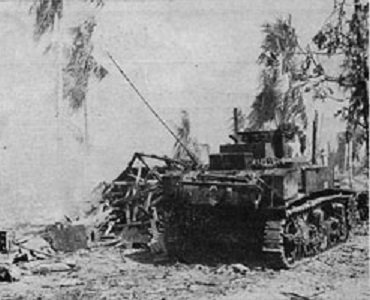
B Company supporting the 184th Infantry Regiment landed on Red Beach 1 while A Company supporting the 32nd Infantry Regiment landed on Red Beach 2. The
Japanese had twin 127mm guns on each end of the island plus 80mm guns on the ocean and lagoon sides.
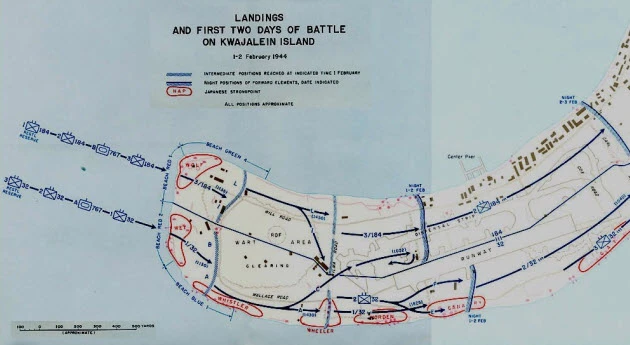
M4A1 #19 “Lightning” landed on Kwajalein Island, February 2. Note that tank #13 in the background has a white star on the lower front hull.
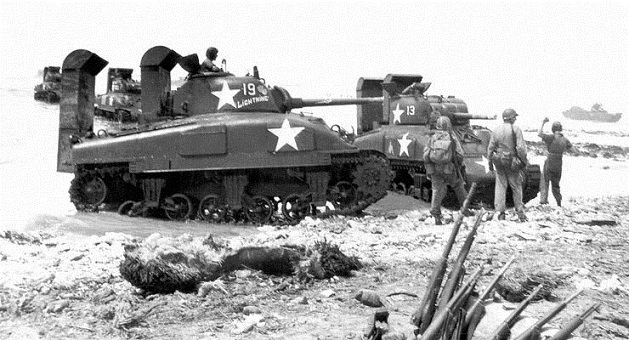
M4A1 with a section of the wading stack on the rear.

This M4A1 is equipped with T48 Chevron tracks. Note the telephone box on the rear to the left of the damaged wading stack.

Infantry wearing checkered identification panels advancing with the tanks. The GIs on the left are manhandling a 37mm anti-tank gun.

The US 7th Infantry Division was the only unit in the Pacific to use these checkered ID panels. Some sources state that the colors were red/white. The color was more likely blue or black since red/white could been mistaken as a Japanese flag. The ID panels were discontinued after this invasion.

Five M10 Tank Destroyers equipped the battalion’s Assault Platoon on Kwajalein Island, February 3. Note the grousers fitted to the tracks.
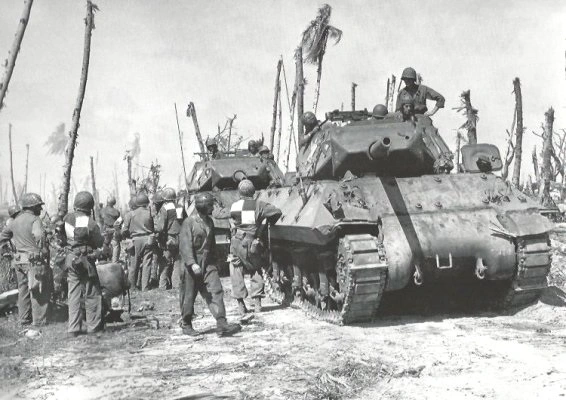
The 3 inch gun on the M10 was more effective than the Sherman 75mm gun for busting Japanese palm log bunkers.

Design of a typical Japanese pillbox. The foliage around the islands were mostly destroyed by the massive aerial bombing and pre-invasion naval bombardment.

The M10s advanced along with the Shermans. Note the number 3 on the M10 turret. The machine gun in the foreground is a .30 caliber M1919A4.

A Japanese sniper concealed in the top of one of those palm trees could easily drop a grenade into the M10’s open top turret.

On the northwest end of Ebeye island (Burton) was a seaplane base that was abandoned during the invasion. C Company supporting the 17th Infantry Regiment landed on Beach Orange 4 on the southwest corner of the island.

C Company M4A1 #58 “Lucky Tiger” and is followed by “Miss Dinah” on Ebeye on February 4.

Close up of “Lucky Tiger”. Note the track grousers and the top section of the wading trunk laid flat across the engine deck.
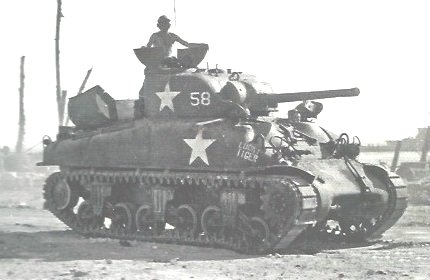
Film: Stock Footage WWII U.S. 7th Infantry Takes Kwajalein Island Color
(Warning: scenes of dead soldiers near the end)
Film: U.S. 7th Infantry Division at Kwajalein Atoll
Film: Battle of Kwajalein (1944 Newsreel)
Although the Japanese counterattacked every night, Kwajalein island was declared secure on February 4. On February 7, the 767th tank battalion re-embarked for the trip back to Schofield Barracks in Hawaii.
Kwajalein airfield after its capture before becoming Bucholz Army Airfield. Later it became a major base and staging area for B-24 equipped 11th Bombardment Group, 30th Bombardment Group and the F-5 (P-38 Lightning) equipped 28th Photographic Reconnaissance Squadron.

LEYTE 1944, Operation King Two
The battle of Leyte was the beginning of Operation Musketeer, General MacArthur’s Liberation of the Philippines Islands. The invasion began on A-Day, 20 October 1944.
Film: Allied Newsreel – MacArthur Lands at Leyte, Philippines 1944
On the morning of A-Day, the US 7th Infantry Division landed at Dulag, Leyte. Accompanied by Filipino troops, the division supported by the 767 tank battalion was fiercely opposed by elements of the Japanese 20th Infantry Regiment,16th Infantry Division. Most of Leyte was covered with swamp areas, rice paddies and tall tough cogon grass. Due to being the rainy season, heavy rain storms lashing the east coast of Leyte made most areas of the island very muddy.

Four of the five Japanese airfields on Leyte were located in the US 7th Infantry Division’s area of operations.
Film: WW2 Philippine Operations, Leyte, 20 October 1944
These are segments from the 767th After Action Report (AAR) for the year 1944. Not all the pages in the AAR are legible and it also contained a lot of entries pertaining to equipment statuses, personnel promotions, transfers and GIs reporting to the hospital.

The Japanese did not have a towed 75mm anti-tank gun, the largest was the 47mm. The gun was probably a Type 38, 90 or 95 75mm field gun.
Before the invasion, four D Company M5A1 Stuarts were replaced by M3A1s modified with a M1A1 flame gun mounted below the hull .30cal MG and these M3A1s were not waterproofed for the invasion allowing them to immediately flame Japanese positions upon landing.

At the end of day, the tanks returned to the battalion’s bivouac area around the crossroads at Dulag-Burauen Road and Highway #1 just southwest of Dulag for night security. The tanks were rearmed and maintenance performed while the crews got some chow and then sleep (if possible).
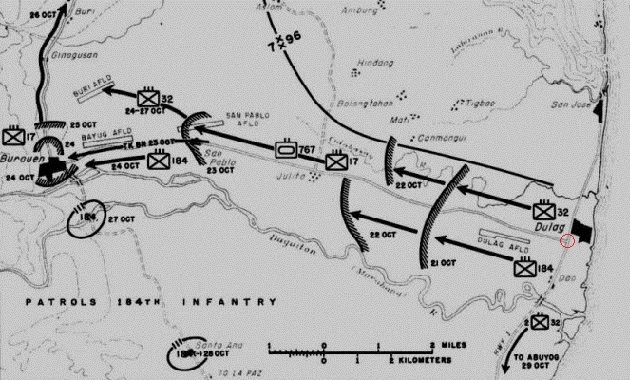
Japanese Type 89B Otsu Medium Tank
Mitsubishi built the Type 89 armed with a short-barreled 57mm gun from 1931 to 1939. The earlier gasoline powered version Type 89A remained in production until 1937. Mitsubishi developed an air-cooled diesel engine and built the new model Type 89B Otsu which went into production in 1933. The Type 89B Otsu was the first diesel-powered tank to be mass-produced in the world. A total of 404 Type 89s were built – 113 Type 89As and 291 Type 89Bs. It was used by the IJA and IJN Special Naval Landing Force.
Film: Type 89 medium tank – IJA Armored Forces Exercise – September 1941
When US forces invaded Leyte in 1944, the only Japanese armor unit in the US 7th Infantry Division’s area of operations was the Japanese 7th Independent Tank Company commanded by Captain Kono which was equipped with Type 89B Otsu tanks and was deployed near Burauen. The tanks most likely were used in China in the late 1930’s and then became part of the occupation force after the Japanese invaded Leyte in 1941-42. By 1944, these tanks were obsolete and only had been used as tractors to clear and roll the airstrips. The tank’s 57mm guns probably were not functional or had no shells for the guns. On A-Day, the tanks were ordered to advance to the east to repel the US invasion forces at Dulag.
The US 7th Infantry Division had dug in for the night on A-Day when the Japanese launched two tank attacks against the division’s night perimeter. A gap existed between the 184th and 32nd Infantry Regiments and Company G of the 184th filled the space. As the company was digging in for the night, 3 Type 89s came down the road and sprayed the area with MG fire but they fired high causing no casualties. Although the company fired rifles, bazookas, and mortars against the tanks, they still managed to escape. An hour later, one of the tanks returned and it was knocked out. A Japanese scout car then sped down the road and its passengers killed 2 GIs and wounded 3 others. The scout car was probably a Kurogane Type 95 belonging the commander and armed only with a MG.
The 3rd Battalion, 184th Infantry setup it’s night perimeter on the north edge of the Dulag airfield with its right flank on the Dulag-Burauen road. At 0130 hours on October 21, three Type 89s moved along road. Pfc. George W. Tilk of Company M stopped one of them with one bazooka shot when they came into range. The other 2 tanks continued down the road but on their return trip they were knocked out, one by the battalion supply detail and the other by Pfc. Johnnie Johnson with a bazooka.
At 0400 hours, 4 Type 89s attacked the 3rd Battalion, 184th Infantry sector. Within 30 minutes, the battalion knocked out 2 of the tanks and the others retreated. At 0530 hours, about 50 Japanese soldiers launched an attack against the perimeter of Company K, 3rd Battalion, 32nd Infantry, with light MG and rifle fire. The GIs broke up the attack using MG, mortar, and artillery fire.
During the day on October 24, 2nd Battalion, 32nd Infantry, captured a Japanese private, Isamu Nakamaru, who was a mechanic with the 7th Independent Tank Company. He stated that his company originally had 11 tanks and 8 of these were lost in action east of Julita while the remaining 3 were at Buri but were not operational. The GIs knocked out 6 of the tanks so 2 of them either had mechanical problems or became mired somewhere.

A jeep and trailer driving pass two knocked out Type 89Bs. Note the chains on the jeep tires.
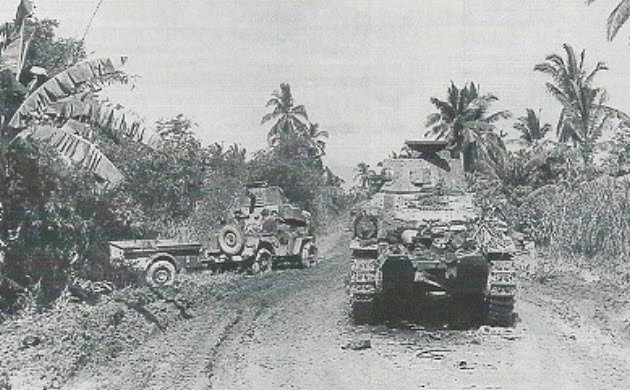

This is probably the other side of the Type 89B above.

This DUKW passing a Type 89B is probably returning to the Dulag beachhead for more supplies.
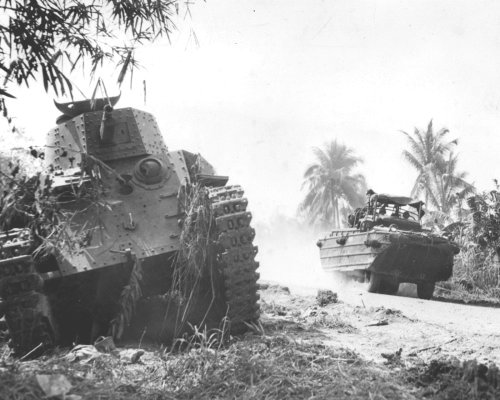
Type 89B top view.

October 21:
This is the only Japanese tank the battalion reported in the AAR. It probably was already knocked out by infantry and GIs could have been around it.

When the attack began, the 767th battalion probably did not send any tanks to aid the infantry due to no orders or requests and it would have been risky at night with trigger happy GIs firing at anything that moved. One of the Type 89s did managed to get through the Infantry defenses and got close to the 767th battalion’s bivouac area before being knocked out or captured by the infantry. Although the 767th battalion did not knock out any of these tanks, they must have drove past them along the Dulag -Burauen road after they left their bivouac area later that morning.

A Japanese truck would made a fast and simple road block for the infantry especially if they expected another tank banzai charge.
For the Leyte invasion, the 767th’s Assault Gun Platoon was equipped with the M8 75mm Howitzer Motor Carriage (HMC) based on the M5 Stuart tank chassis. These M8s of an unknown unit were supporting the US 1st Cavalry Division further north on Leyte somewhere near Talcoban. The grouser racks on side of the turrets would be empty as the grousers were installed on the tracks.

October 23:
A disabled M4A1 on the Dulag-Burauen Road (3,000 yards west of Julita). The large number of track grousers were definitely required on Leyte.
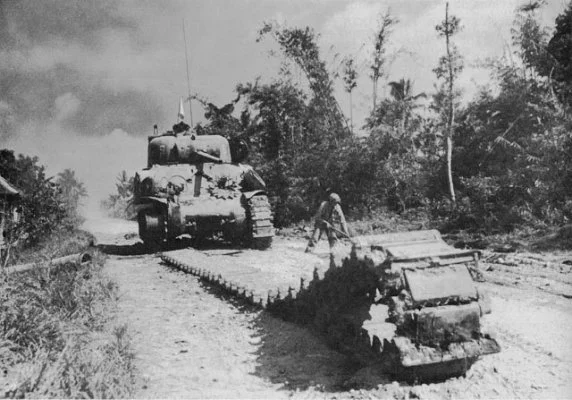
This M4A1 was probably HQ tank No. 6 as indicated in this AAR entry.
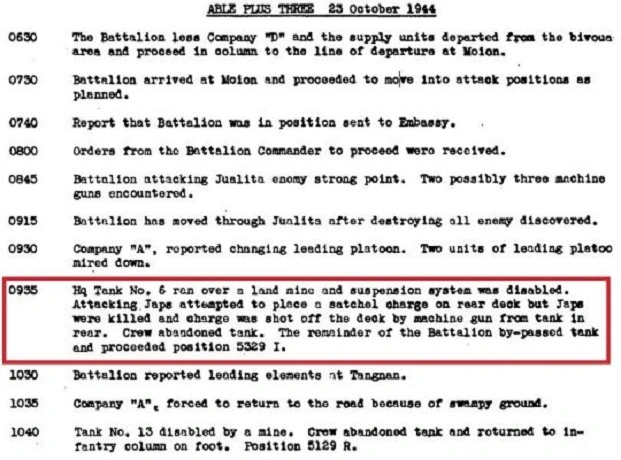
October 24:
M4A1 #28 “Man O’ War” advancing through the village of Julita with a Filipino civilian guide was with the armored column which captured the San Pablo Airfield. The two antennas indicate it was a command tank. Note there is no pistol port on the turret and the stamped road wheels.

This is “Man O’ War” later crossing a small stream. This front view shows the commander’s hatch was the split type.

Dulag Airfield
On October 25, a TBM-1C Avenger and other US Navy planes are seen on the Dulag airfield. During the Battle for Leyte Gulf (October 23-26), Dulag was used as an emergency airfield for stranded US naval planes due to out of fuel, battle damage or their carrier was put out of action. While attempting to land on the muddy landing strip at Dulag, 8 out of 40 naval planes crashed.

This is my close up which shows an officer with a couple of local women. A censor had whited out the ladies and the lower half of the officer was blacked out. Wonder why? Between the planes is the nose of a LVT-4 amtrack which probably belonged to the 718th Amphibian Tractor Battalion. After the initial landings, amtracks were used to move fuel and ammunition to the front lines. This amtrack was probably used to tow planes off the muddy landing strip. Note barely visible in the background is probably a D Company M3A1 or M5A1 Stuart tank.
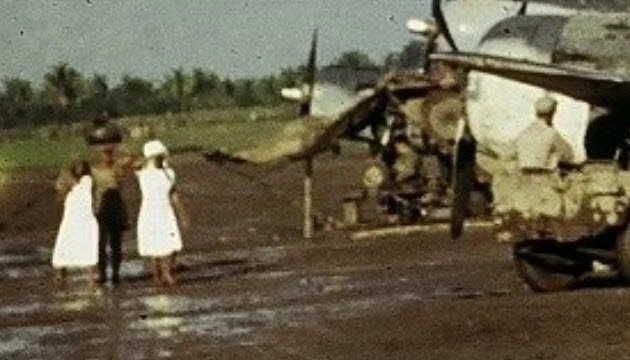
Dulag airfield was built by the Japanese during their occupation in 1943. After its capture a few days earlier, US engineers began to improve and widen the runway which later became a major base with revetments and taxiways on the sides of the landing strip. On October 28, HQ and maintenance elements of the US 475th Fighter Group (P-38 Lightnings) arrived at Dulag and began setting up for operations.
October 26:
After Burauen was captured and secured, C company supported the 17th Infantry regiment moving north through Buri towards Dagami.
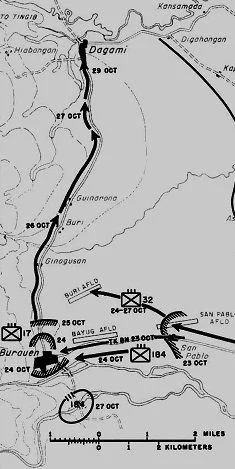
October 28:
Tank C-44 had a really bad day. The crew was trapped in their hot and cramped tank surrounded by the Japanese for over 8 hours.

The 17th Infantry supported by the 767th was moving north along the Burauen Dagami road while the 382nd Infantry, US 96th Infantry Division was approaching from the east on the road between Dagami and Tanauan. By 1040 hours on October 30, Dagami was securely in US hands and the 17th Infantry continued to mop up.
Although the 767th did not knock out any Japanese tanks they did claim two Japanese planes which were strafing the regimental dump and bivouac area. Maybe they painted small airplane kill markings on their tank.

November 1:
Light tanks extricated a mired M29 carrier (Weasel) and trailer.
The M29 probably belonging to the 17th Infantry Regiment.
November 2:
AAR lists HQ, A, B and C companies had 51 medium tanks (M4A1s) operating. D company had 11 light tanks (M3A1/M5A1 Stuarts) operating. The service company had operating: 12 2.5 ton trucks, 1 wrecker (10 ton), 11 1/4 ton trucks (Jeeps) and 8 Halftracks. First platoon of B company reported to 17th Infantry regiment but no mission was present.
November 3:
Battalion received order to waterproof one platoon of medium tanks of B company. The mission was unclear and then there was a change in orders. From this date to the end of the year, the 767th AAR does not list any actions involving the medium tanks.
During this period, the 767th Tank Battalion bivouac was located in Burauen. Personnel carried out normal maintenance and policed the bivouac area. Details consisting of personnel from A and B companies provided security for San Pablo airfield. In other words, the tank crews were doing busy work and were assigned guard duty. November thru to January was the height of the rainy season on Leyte with the heaviest rain fall.
November 13:
Pyramidal tents were setup in the battalion areas in Burauen. Now it appears they were settling in for the duration.
November 15:
2nd platoon and Maintenance section of D company left Burauen at 0500 hours for Baybay on the southwest coast of Leyte where they were attached to the 32nd infantry regiment, 7th Infantry Division camp at 1200 hours.
November 19:
2nd platoon and Maintenance section of D company left Baybay at 0730 hours and proceeded north along the coast to Damulaan where bivouac was made. The mission was to setup a beach defense.
November 22:
The US 11th Airborne Division relieved the 7th Infantry Division, minus the 17th Infantry. The 7th Infantry Division was ordered to relocate to Baybay for the advance north to Ormoc.
November 23-25:
A platoon from the 7th Reconnaissance Troop patrolled the road between Baybay and Damulaan and a platoon of 767th Tank Battalion Stuart tanks at Damulaan were the only US armor on the west coast of Leyte at that time.
December 4:
C Company personnel left for a work detail at Yellow Beach #1 south of Dulag. Now the tank crews were doing manual labor unloading supplies.
December 5-6:
Operation Te-Go
Teishin Shudan (Raiding Group) was a Japanese special forces/airborne unit during WWII. The unit was a division-level force and was part of the Imperial Japanese Army Air Force (IJAAF). Some 750 men, mainly from the 2nd Raiding Brigade of this unit were assigned to attack US air bases on Luzon and Leyte. The Japanese paratroopers were flown in Mitsubishi Ki-57 transports with a crew of 4 (pilot, co-pilot, navigator and radio operator) each carrying 10-11 paratroopers.

During the night, most of the Ki-57 transports were shot down enroute. One plane load of paratroopers were lost when the paratroopers jumped their anchor line failed causing their parachutes not to deploy.

Around 200-300 Japanese paratroopers and elements of the Japanese 16th Infantry Division attacked the airfields around Burauen and setup a road block on the Burauen-Dagami road north of Burauen. They attacked the airfield and the bivouac areas of the field personnel destroying their camp and set fire to everything flammable. Five L-5 Sentinel light reconnaissance planes and one C-47 transport on the airfield were destroyed. Some 475th FG P-38s and 110th TRS P-40Ns of the 5th Air Force had been at San Pablo airfield during first half of November before relocating to the airfield at Dulag. At this date, the 5th Air Force only used the San Pablo airfield for emergency landings
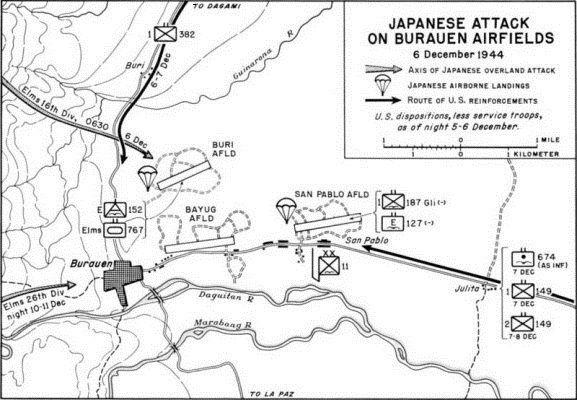
The field personnel (including 767th security detachments) and nearby units of the US 11th Airborne Division defended the airfields. The San Pablo airfield was secured on December 7. “EM” in this AAR segment stands for Enlisted Men.

December 7:
D Company HQ section (2 light tanks) reported to San Pablo for security.
One tank was used for evacuation of stalled and disabled vehicles in the area.

December 10:
D Company locations as listed:
– 1st platoon at Dulag waiting transportation to Baybay, west coast of Leyte.
– 2nd platoon in action at Damulaan advancing north towards Ormoc.
– 3rd platoon and HQ section at San Pablo and Burauen.
December 14:
1st platoon Company D left Dulag by water transportation (LCM) for Baybay.
December 20:
D Company locations as listed:
– 1st platoon on west coast of Leyte.
– 2nd platoon engaged in combat on the west coast of Leyte.
– 3rd platoon and HQ section at Burauen, Leyte.
Have not found any information on what became of the battalion’s M4 tanks or anything on the 767th tank battalion in 1945. The tanks and crews were probably transferred to other tank battalions and the battalion was then deactivated with the remaining personnel transferred to other units.
POST WAR
Today, these airfields are completely overgrown with grass and brush.
Dulag Airfield in 1946.

San Pablo Airfield in 1946.

This Type 89B is claimed to be one of the 7th Independent Tank Company tanks captured on Leyte. It was shipped to the Aberdeen Proving Grounds for evaluation and then was on display outside at the US Army Ordnance Museum at Aberdeen for about 60 years. In 2008, it was repainted overall white but was not restored.

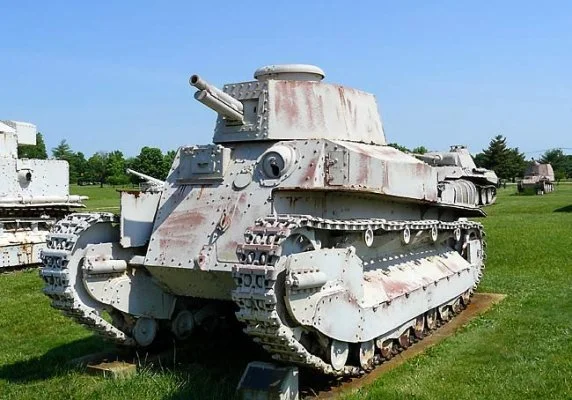


Type 89B Otsu at Aberdeen Proving Ground: Walk Around Photos
Aberdeen Type 89B tank video:
The number plate on the front hull is not an original marking.
The guy in this video does not know much about the tank.
Video: Type 89 Otsu Tank at Aberdeen Ordnance Museum
Sometime after the Aberdeen Museum closed in 2010, it was moved to the US Army Center for Military History Storage Facility at Anniston, Alabama.

The hole on the side of the turret is not a shell hole which knocked out the tank. It is a circular port for ejecting spent shell casings and it is missing the plug or cover.
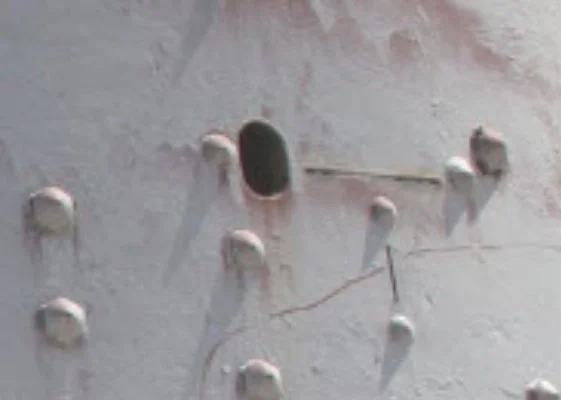
The Type 89B at Anniston: More Walk Around Photos
Have not found any information if this tank was ever or will be restored.
MODEL DECALS
Decal Sheets containing #19 “Lightning”:
1/35: ToRo Model 35D59 PTO Sherman tanks vol.3
1/48: ToRo Model 48D09 PTO Sherman tanks
1/72: ToRo Model 72D46 PTO Sherman tanks vol.2
Decal Sheets containing #58 “Lucky Tiger”:
1/35: Bison Decals 35070 US M4A1 Sherman in the Pacific
1/35: ToRo Model 35D57 PTO Sherman tanks vol.2
1/48: ToRo Model 48D22 PTO Sherman tanks vol.2
1/72: ToRo Model 72D45 PTO Sherman tanks vol.1
Decal Sheet containing #28 “Man O’ War”:
1/35: Bison Decals 35070 US M4A1 Sherman in the Pacific

you’ve an ideal blog here! would you prefer to make some invite posts on my weblog?
LikeLike
I went over this website and I think you have a lot of excellent info , saved to favorites (:.
LikeLiked by 1 person
Thank you for every other informative blog. Where
else may I get that type of info written in such a perfect means?
I’ve a project that I’m simply now running on, and I have been on the
look out for such information.
LikeLike
Woah! I’m really digging the template/theme of this site. It’s simple, yet effective. A lot of times it’s tough to get that “perfect balance” between usability and appearance. I must say you have done a very good job with this. Also, the blog loads extremely quick for me on Chrome. Superb Blog!
LikeLike
Hey Mike. Watched the one video in color about Kwajalein. The “vests” look very much like dark blue and white. I took some screenshots.
Mike
LikeLike
Mike, Great page with lots of information. Question, I was looking at the book on Gen Jacob Devers and in it it mentions the 767th TB as an African-American tank battalion. Based on some of the photos this may not be true or it is a segregated tank battalion. Do you have any information on this?
LikeLike
Karlen –
AFAIK, the 767th TB was not a segregated tank battalion. The 761st “Black Panthers” was the African-American TB which fought in the ETO.
LikeLike
Great research. My Dad served in Company D of the 767th Tank Battalion. He was a gunner on M4A1 Tank #23. I have a photo of him and tank crew. Great way to honor their service. Thanks!
LikeLike
Great site! My grandfather was in C Company.
LikeLike